Walt Disney started the 1950s in a delighted mood. Cinderella wasn’t just a hit—it was doing so well that he finally had funds to start up his next dream project, a little thing he called Disneyland. And possibly start shifting his movie studio towards making live action films, since the joint cartoon/live action experiments had, for the most part, done decently at the box office.
Alas, the films that immediately followed Cinderella did not do quite as well at the box office. This wasn’t just the usual revenue problem: Walt Disney needed a film to keep up the interest in his company and build the Disney brand as he started to build Disneyland. Disney did have another animated film in production, the lavishly animated Sleeping Beauty, but for multiple reasons, that film was mired in production delays. Disney needed a new animated film relatively quickly—something easy to animate, with clear popular appeal. Those little mice had unexpectedly become the showstoppers of Cinderella, and Disney had generally—Bambi aside—done well with cartoon animals. Why not something about dogs?
Like most of the Disney animated films of the 1950s, this was not a new idea. Animators had been toying since the mid-1930s with the concept of a film centered around a dog called Lady, very loosely based on an English cocker spaniel owned by Disney artist Joe Grant, and a moment from Walt Disney’s own life, when he had decided to apologize to his wife by giving her a puppy in a hat box. Unfortunately, however adorable, Joe Grant’s dog and a hat box were not quite enough plot for a full length feature. Still mulling over the concept, Walt Disney read a story in Cosmopolitan that had a dog character he could work with, and bought the rights to the story. (This would be the story I was unable to track down for the Disney Read-Watch.) By then, however, war had broken out in Europe, impacting the Disney studio, and forcing the still sketchy dog film to be set aside for several years.
Sidenote: Joe Grant ended up leaving Disney before Lady and the Tramp went into production, but would later return right before the Disney Renaissance of the 1990s, as one of the artists who helped restore the studio to its greatness, and continue to draw for the studio right up until the day of his death in 2005 at the age of 96. It was a lovely coda both for his career and for the company that helped immortalize his dog.
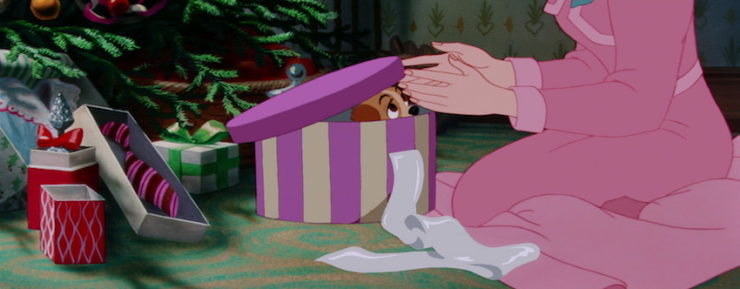
Now that it was back into production, Walt Disney made several decisions. First, to distinguish the film from its three predecessors, and once again showcase the potential range of Disney animation, Walt Disney announced that for this film, animators would need to draw realistic looking dogs, not mere cartoons. He also ordered the film to remain at the eye level of a dog whenever possible, creating issues of perspective for both background artists and animators. Which is to say, if you’ve ever wondered why Darling’s hair is a different color every time it appears on screen—well, it appears on screen so rarely that apparently no one thought of deciding on a color for it. Second, Walt Disney decided that Lady and the Tramp would be filmed with CinemaScope, 20th Century Fox’s latest innovation, first used in their 1953 Biblical drama The Robe.
For technically minded people, CinemaScope represents a major development in cinematography, featuring a lens developed by Bausch & Lomb that could create films in a 2:66:1 aspect ratio, initially squeezing the image before expanding it during projection, allowing film directors to dramatically change the composition of shots. It also allowed studios to add stereo sound to their films, a technological jump that would eventually lead to home sound surround systems. For less technically minded people, like me, CinemaScope was the first appearance of what we now call “widescreen,” signaling the start of major changes in the overall film industry. Apart from various technical advantages, CinemaScope provided an immediate advantage to film studios: it ensured that films viewed in the theatre would have a different “look” than anything viewed on a still new and exciting medium moving into U.S. households: television.
Unlike 20th Century Fox executives, Walt Disney was not particularly worried about television, correctly foreseeing the new medium as something that would eventually benefit his company. But he could not resist the opportunity to play with a new technology. Anything that allowed innovation with a soundtrack was bound to interest a man who had created a new sound system for a single film, but Disney was also fascinated by the animation potential offered by the widescreen format.
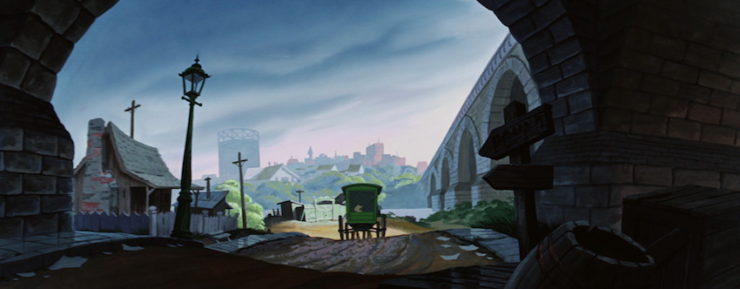
The artists working on Lady and the Tramp had only one objection, but it was a major one: they had already finished designing the film to fit the non-widescreen ratio, and now had to figure out how to move all of their little animated figures across a much wider screen and redesign some of the backgrounds. As they worked on accomplishing this, Walt Disney threw them another bombshell: several theatres—many harboring unkind feelings about 20th Century Fox—would not have projectors capable of showing CinemaScope. Thus, the animators would have to finish two versions of the film using both aspect ratios in the time frame budgeted for just one version.
Incredibly, most of the artists did not immediately quit.
It’s possible that they just liked dogs, or their work. Or it’s possible that by that time, they realized that in Lady and the Tramp, they had something new for Disney on their hands: a genuine romance. About half of the Disney films had no romance at all. The Prince Charmings of both Snow White and Cinderella and the centaurs of Fantasia had been such ciphers that they hardly counted as romances, and the less said about the animal hookups in Bambi the better.
In contrast, Lady and the Tramp follows all of the beats of a traditional romance, introducing two dogs from very different backgrounds, who meet, have an immediate misunderstanding, adventures, a romantic night out on the stars complete with spaghetti, meatballs and a singing chef, and more adventures before finally joining forces to take down an evil rat. Incidentally, in another change from many Disney films, the rat is the closest thing Lady and the Tramp has to a major villain. Oh, minor villains—the Siamese cats, the dog catchers at the pound, the mean dogs who terrorize Lady, the rat—abound, but no major ones. Not even Aunt Sarah, who puts a muzzle on poor Lady and later ties her up to the doghouse, since she’s not exactly a villain. She just misunderstands the situation, getting tricked by her cats and a rat. And not even the dog catcher who runs down and kills Trusty the dog—largely because, as small horrified viewers soon learn, Trusty is not dead yet. Indeed, he’s getting better.
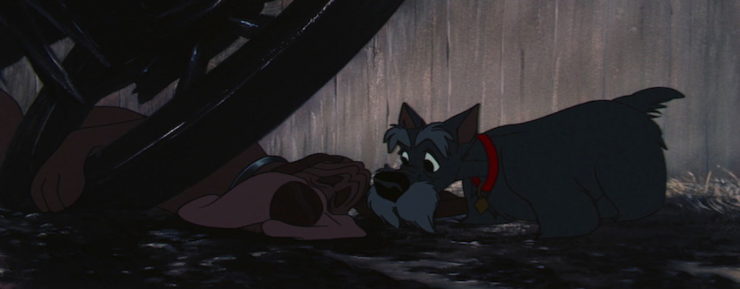
That was a last minute change made by Walt Disney, still smarting over the negative reception to the death of Bambi’s mother just a little over a decade earlier. This death, he decided, was even worse—we never do see the body of Bambi’s mother, but Trusty is right there, beneath the wagon wheels, not moving, while Jock howls beside him. It’s a jolting moment in an otherwise fairly quiet film, but having Trusty make an appearance just moments later is not really all that much better. Sure, Snow White had previously “died” and returned to life—but that was in a fairy tale, not in a—mostly—realistic depiction of dogs.
It’s probably worth noting that the dog who dies mostly offscreen—Nutsy—stays dead.
But back to the romance. Lady and Tramp, as their names suggest, aren’t just from two different worlds, but have very different personalities. Lady is so sheltered, and so young, that she knows almost nothing about life beyond her family and her fence. She even has to be told about babies. Tramp has had so many hard knocks that he’s turned into a cynic, especially about babies. But Lady learns quickly, and Tramp mellows quickly. Possibly the best part of their romance is how much they improve each other, with Tramp expanding Lady’s horizons, and Lady teaching Tramp responsibility.
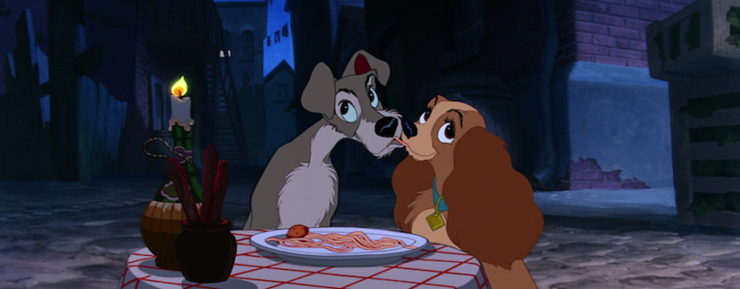
The second best part of their romance is, of course, their legendary scene with spaghetti and meatballs, so legendary that I was braced for it to be completely awful. It turns out, however, to be genuinely sweet, with the accordion music just barely preventing it from being too syrupy. I mean, Tramp gives Lady the very last meatball. That, everyone, is true love. Even if he does completely blow it the very next morning by convincing Lady to try something that she really doesn’t want to do—chase chickens—something that leads her into danger.
A few things about the film have not dated all that well—most notably the decision to give pretty much every dog some sort of ethnic identity, followed by the decision to leave the Russian and the Mexican dogs in the pound along with the streetwalking and other doomed dogs, while the American, American South and Scottish dogs enjoy a luxurious life in gated mansions.
And the decision to have the mean Siamese cats speak in vaguely Chinese accents, though I ended up having slightly mixed feelings on this. On the one hand, having the American voiced dog bravely try to save the goldfish and the baby from malicious Siamese cats who sing a song meant to be vaguely reminiscent of Chinese music is….well, it’s not great, let’s start there. On the other hand, I spent years sharing a home with a cat who took positive delight in swiping things off shelves despite being told in no uncertain terms that said things belonged on shelves, and another cat who, as the superior lifeform on the planet, apparently felt that tormenting lower forms of life, which included, but was not limited to, dogs, was part of her job. That is, these Siamese cats are, well, cats, and if their song had been voiced in pretty much any other accent, and given any other melody, I’d be applauding the realism. Unfortunately, however, they are speaking in vaguely Chinese accents.
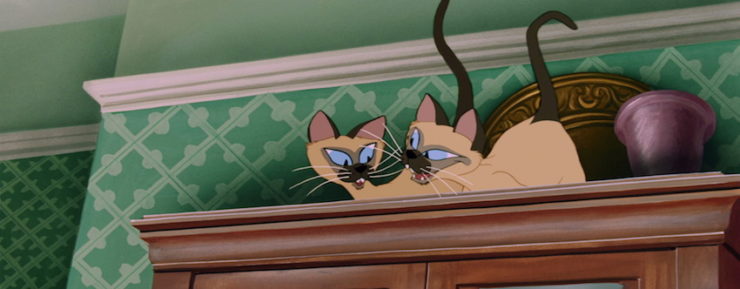
And speaking of realism, in my experience, at least, dogs love their people—sometimes a little too much—and thus, Tramp’s delight at finding a home and people feels genuine. And certainly, after risking his life and freedom to kill a rat, he deserves some reward. But I also can’t help feeling a little sorry to see the freedom loving Tramp, who dreamed of adventure and seeing the world, wily enough to turn almost every human into a friend (except the dogcatcher) transformed into a licensed, stay at home dog.
But it does fit the main message of the film, which is, perhaps not surprisingly for a 1950s film, a conservative message that deeply stresses the importance of turning away from adventure for the comforts of home. It’s not just with the dogs, either. Jim and Darling’s little baby is perfectly safe right up until the moment the couple takes off, with Darling feeling that the little baby is just too little to be left alone, even with guardians like Aunt Sarah and Lady.
Sure enough, not only does this lead to a pretty terrifying experience for poor Lady, but as a result of that experience, the baby is almost—almost—eaten by a rat, since Lady, chained outside, can’t stop the rat. I suppose we could argue that, in a way, the baby is also saved because Jim and Darling took off. After all, their departure led to Lady running away from Aunt Sarah, which led to Lady meeting up with Tramp again, which led to Tramp hanging around the house, ready and able to rescue helpless babies from rats at a bark’s notice. But not only is Lady perfectly capable of stopping a rat without Tramp’s help—as long as she’s not chained up—Tramp and Lady had met well before this. I think it’s very safe to say that Tramp might have been meandering about, ready to rescue babies and impress Lady, even if Jim and Darling had never left their house, and equally safe to say that the film, at least, strongly believes that everyone would have been safer had Jim and Darling stayed at home.
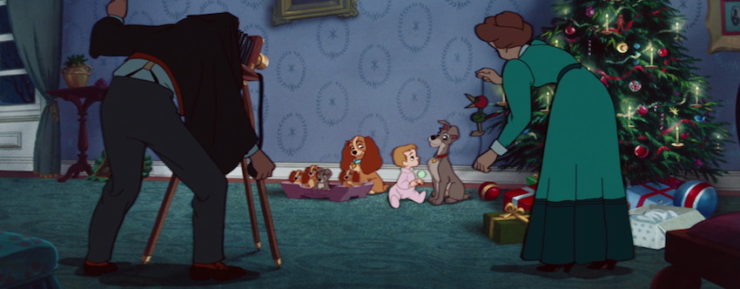
To slightly counter this, in at least one case, when Lady and Tramp sneak into the zoo to get her muzzle removed, breaking the law turns out well. And their wandering the streets without a leash does lead to a night of romance and spaghetti. But it also leads to terrifying, humiliating moments for Lady, as she learns what happens to dogs without licenses. Spoiler: they get dragged away off screen to die. Trying to prevent an unlicensed dog from that same fate leads directly to Trusty’s not-actually-a-death. Meanwhile, whatever my feelings about Tramp and freedom, it only takes Tramp a few months at most to accept the comforts of home and puppies, in a message repeated again and again in the film. The dogs who have homes and licenses take pride in them; the dogs without homes long for licenses. Darling and Jim Dear are happiest at home.
The film itself drips in nostalgia: this is not the 1950s, but some earlier, unspecified period right before World War I, judging by the glimpses of clothing and technology, a period that Walt Disney remembered with fondness. It might not be easy for everyone, as the dogs in the pound point out, but for dogs—or people—who obey the rules, remember their duties, and stay at home, it’s happy.
Whether it was the nostalgia, or the romance, or simply the adorable dogs, Lady and the Tramp was a hit, managing to outperform both Cinderella and Snow White at the box office, and continuing to earn money on subsequent releases. Decades later, Disney capitalized—or tried to capitalize—on nostalgia for the film by producing an atrocious sequel, Lady and the Tramp II: Scamp’s Adventure. Long term, merchandise—including art based on the film as well as the ubiquitous plush toys, clothing and Disney trading pins—proved even more profitable. Disney never managed to find a way to turn Lady and the Tramp into a theme park ride, and the realistically drawn characters never appear at Character Meet and Greets. But Lady and Tramp’s romantic spaghetti dinner could and did get referenced at various Disney restaurants and occasionally at the Epcot Food and Wine Festival. It remains one of Disney’s most classic and successful films.
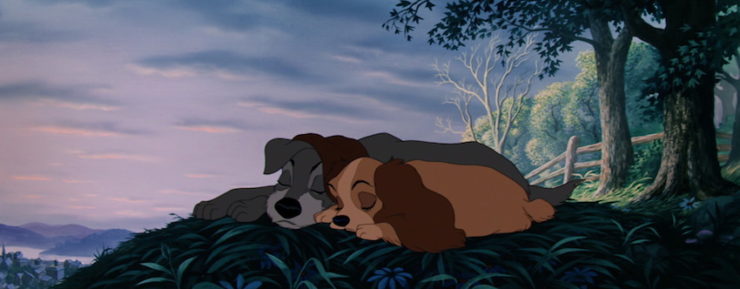
Next up, a film that was not quite as successful, at the time or later: The Aristocats.
Mari Ness lives in central Florida.










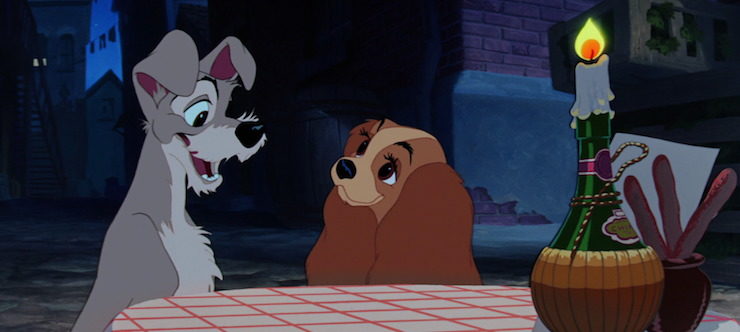
This may be way off the mark, since I haven’t seen Lady and the Tramp in decades (and I’m not sure I’ve ever seen the whole thing), but I just saw Zootopia, and it occurs to me that that film’s lead characters Judy and Nick resemble Lady and the Tramp just a bit, both in appearance and in personality up to a point (Judy is idealistic and sheltered, Nick is a streetwise scoundrel). It’s a very different, much more modern story, since Judy is looking for career success and a trustworthy partner/friend instead of a husband, home, and hearth, but maybe there is a certain resonance.
Interesting – I associate Disney with romance but you’re right in that this is really one of the first big romances (although I do consider Snow White and Cinderella romances of a sort). But this is definitely the first one to really focus on their relationship as the main point of the movie. This was definitely one of my childhood favorites.
I hear you about the “Siamese” cats getting the stereotypical Chinese accents (I’m assuming the Chinese is because they are Siamese, although I’m pretty sure Siam isn’t even part of China so that actually makes it more offensive…), but man, I was obsessed with those cats and that song as a kid. This was before the internet made things easy, but I was thrilled when my grandmother handwrote all the lyrics for me (she probably had to watch that scene a bunch of times to transcribe them!). Although this is relatively tame compared to Aristocats and the, uh, ‘ethnic identities’! But we’ll get there. As for the demographics of the pound vs. mansion dogs that seemed to me more of an ‘art imitates life’ kind of thing, I guess, given that the demographics of the actual mansion community probably WAS mostly comprised of Anglo Saxon humans. (But yes, why do they need to all be a particular ethnic identity in the first place is a question. It seemed to be a kind of easy/lazy go to for creating ensemble casts…).
I definitely see the pro family, pro comforts of home, pro ‘licensed’ dog/settling down after some adventure type of slant (although perhaps there IS some sympathy there for the unlicensed dogs; none of them are potrayed as ‘bad’ although I do think you’re intended to pity them; and in fact Lady and even Jock seem somewhat forced to evaluate their own prejudices/privelege on the topic). But I’m not sure I agree that the message is that Jim and Darling should have stayed at home. The baby would have been perfectly safe with Lady and Aunt Sarah had Aunt Sarah not been such a jerk and prejudiced against dogs! At least in my child mind, Aunt Sarah was clearly the one being painted as a villain and the one in the wrong, especially in the way she assumed the worst about the Tramp because of his ‘tramp’-ness* (in truth, I probably had no opinion about Darling and Jim Dear’s behavior at all, except that I remember thinking the baby shower scenes were funny and was always a bit confused as to why the men and women were in separate rooms!)
*(In all fairness I probably would not respond well to a stray dog in my house either! But if you want to know the truth, despite my love of this movie, I’m a cat person, and I tend to dislike (and fear) dogs. And of all our childhood pets – we’ve had plenty of dogs and cats over the years – the dog I really felt closest to was a sweet, older cocker spaniel we rescued from the pound)
@2/Lisamarie: Yes, Siam is an older name for Thailand, which is in Southeast Asia, separated from China by Myanmar and Laos. The Thai people are a distinct ethnic and linguistic group from the Chinese, although ethnically Chinese people make up about 1/7 of Thailand’s population (the largest Chinese population in the world outside of China, according to Wikipedia).
I mean, Trump gives Lady the very last meatball.
Wow, now that’s a typo!!!
Hah, so maybe Si and Am (yes, they have names ;) ) are Chinese Siamese cats then. (Of course that’s totally what they intended!)
@@.-@ – Fixed, thanks! :)
Oh, and regarding Tramp, I got the impression that he HAD been a house dog at some point, but was then kicked out due to a baby by some callous family, which is why he only allowed himself to have the ‘week day’ families and not get too attached.
@5/Lisamarie: Most Americans back then seemed to treat everything from the Mideast to the Pacific Islands as a single interchangeable “mysterious East.” Which is how we got such nonsense as Jonny Quest‘s Hadji, supposedly a Hindu fakir whose name is a Muslim honorific. Or the cliche of “Chinese” stereotype characters saying “Ah so” (which is Japanese) and inverting their Rs and Ls (which is also Japanese, sort of).
I can’t resist; it’s just too funny.
I know, it’s a simple typo, but it’s FUNNY! Mari, you’re doing a great job, keep it up.
It’s been 20 years since I’ve seen this film. One of my pet peeves has always been to figure out when exactly and where this film took place. Some of the impounded dogs make a cameo appearance on 101 Dalmatians, most notably Tramp’s previous squeeze.
I like it that the film employs some class friction between the dogs, mostly between Jock and Tramp. Speaking of Jock, thanks for clarifying the film’s ending. It looked like Trusty was very much dead at that scene. As a kid, it was a powerful moment, but not that traumatizing. Obviously the epilogue plays a part in that. Ironically, I never had a problem with Bambi’s mom.
Since I’ve only seen Lady and the Tramp on VHS, I’m going to rewatch it, and this time in widescreen. I’ve always loved this film’s background design, and had no idea this was composed in CinemaScope.
@10 I always figured that those dogs who appear in both LADY AND THE TRAMP and 101 DALMATIANS were the equivalent of those “contract” character actors who’d appear in similar “type” roles in movie after movie during Hollywood’s Golden Age.
I appreciate the homey comforts of this movie, and the high society represented by the mansions and the licensed dogs. I like how Tramp gets Lady out, but that he is eventually welcomed in.
Any comments on Jock and Trusty essentially offering to marry Lady after her one night stand? As a kid, I didn’t get it, but it makes adult me giggle.
Aunt Sarah is the main villain to me. And those cats are her sidekicks. Through her distrust and cruelty, she exposes Lady to dangers beyond her ken. So maybe it has less to do with leaving home, and all to do with trust. After all, the rat couldn’t have gotten in if Lady had allowed Tramp to stay and talk that evening, and that would have been less dangerous for the baby and certainly for Trusty as well.
I also thought I’d mention the sweetness and care with which Trusty’s disability is handled. These dogs care for each other, and that’s a big part of what makes the story good.
I may have worn out our tape of this one as a kid. (My dad, in a true labor of love, precisely cut out all commercial breaks by fiddling with the VCR settings when he taped it. As a result, there’s about five seconds of a few opening shots missing, and the entire section from the pound is unwatchable due to tape degradation. It’s close to the middle of of the roll.)
Looking back, however… the stereotypes do really jump out. Obviously I didn’t get them as a kid, because they were associated with animals, not people, but particularly Si and Am are hard to watch now that I know.
On the other hand, there’s totally a photo of five year old me and my best friend sharing a plate of spaghetti lying around somewhere.
This was one of my favorites as a kid, though probably more due to the “story and songs” record than the movie itself. I’m not sure when I even first saw the actual movie. I don’t think they used the actual soundtrack for everything on the record, though, because I was surprised by just how “Italian” “Bella Notte” sounded in the film when I saw it when I was in college, after a very long hiatus. They didn’t overdo the ethnic accents so much in the songs on the album. To this day, I can still sing most of the songs. My mom has photos of 4-5 year-old me leaning against my toy piano and singing “He’s a Tramp” into the cylinder from my blocks set.
There used to be a Sunday newspaper comic about the adventures of Scamp, Lady and Tramp’s son. When one of my dad’s students gave him a puppy, that was the first name that came to mind, so I had a Scamp of my own.
Everyone – Whoops on the typo there. Thanks for catching/fixing it!
ChristopherLBennett – I actually haven’t seen Zootopia yet. That’s coming up, though.
Lisamarie – Oh, Aunt Sarah is definitely prejudiced against dogs and fails to notice what her cats are up to, but I don’t think Lady and the Tramp is particularly subtle here – all is safe and well at home until Jim Dear and Darling take off, leaving their home in the care of a stranger.
Eduardo Jencarelli – Walt Disney ordered the animators to keep the film’s time and place ambiguous: from the costumes and cars, we can presumably say probably early 1920s; the place someplace in Midwestern America, but both of those are arguable. It’s more of an idealized place that never really existed.
KYS – Well, Lady was out with a Tramp (pauses to make sure that I’ve typed that correctly this time) all night. HORRORS. Plus, given the appearance of the puppies, I feel we can make some assumptions about what happened that night.
Yeah, it’s a very Victorian moment, but the dogs are gentlemen. Beyond the one night stand issue, though, I think there’s something else here – when Jock and Trusty show up, there’s at that point a very good chance, in the minds of the dogs, at least, that Aunt Sarah might kick Lady out completely, leaving her homeless. So it’s partly for the purposes of defending her chaste reputation, and partly to ensure she has a home.
Quill – Disney did its usual stunt of pulling the U.S. DVD/Blu-Ray from shelves for a few years, but that’s always followed by another release, so I think you can replace your worn out copy eventually.
Shanna Swendson – Awwwww!
A stranger??? It’s his aunt!
Also, actually things don’t really go to crap until right as they’re about to come home (the rat attack) – I don’t recall anything bad happening aside from that (and Lady running away – which again, is directly due to Aunt Sarah’s treatment). So I have to respectfully disagree with that interpretation :) Presumably things were just fine (baby safety wise) for the rest of the vacation (a weekend? I don’t remember how long they were actually gone) and any issues were due to Aunt Sarah, not the parents leaving (aside from indirectly, I guess – but the parents leaving could have gone perfectly fine too).
So Disneyland is Cinderella’s fault.
As a kid, I was creeped out by Tramp’s illustrated description of how the baby would ruin Lady’s life — “You’ll go from those steak things to leftover baby food, from a warm bed by the fire to a leaky doghouse.” Otherwise I liked the film the one or two times I saw it. But I hope it didn’t excessively inspired the giving of puppies in boxes as unexpected Christmas gifts. That’s risky for everyone.
Do I recall correctly that Darling asked the color of her unborn baby’s eyes when they saw the sonogram or whatever? Weird.
Si and Am did not make the Cracked list of “The 9 most races Disney characters.” The list does feature the more anthropomorphized and extravagantly caricatured Siamese Twin Gang from Chip ‘n Dale, so maybe it would’ve been considered repetitive.
@2: That song made me inevitably obsessed with Siamese cats for a while, too. On principle, them being portrayed as villains. I wasn’t a fan of the rat, probably because its role was important but so brief I barely remember it now.
@14: There was also a sequel film, Scamp’s Adventure. I haven’t seen it and have heard little about it except that it defied genetics by having Scamp look like Tramp and his sisters look just like Lady.
@17/AeronaGreenjoy: I don’t remember the movie, so I don’t know what you’re referring to about the baby, but fetal ultrasound wasn’t developed until the 1960s and didn’t start to become widespread until at least the ’70s.
There definitely was not a sonogram, but there was a scene where Jim Dear is excitedly calling Aunt Sarah to tell her the baby was born and I do think that maybe he forgot to check the eye color or something like that.
I just remember her running around yelling “Oh boy, it’s a boy! Eyes. What color are they?” I don’t know how they learned that, but I think it was before the baby was born.
That’s definitely the doctor scene during the birth, and it was Jim Dear. Darling doesn’t really do a lot of running, or yelling :)
Huh. When asked the eye color, someone responded “It’s too early to tell.” I think so, anyway. I haven’t watched it in about 20 years.
@22/Aerona: There was no way to determine the sex of an unborn child until ultrasound became common. The only time you could find out was just after birth — which is why it was treated as such a big, exciting revelation, because it was something the parents had been waiting 9 months to discover. (Even after ultrasounds became common, a lot of parents still insisted that their doctors not reveal the sex to them, because they didn’t want to “spoil the surprise.”) The reason it was too early to tell the eye color is because newborns don’t have iris pigmentation. All babies are born with transparent irises that appear blue-gray, and it takes several months for the final eye color to develop.
In terms of gender roles, Lady and the Tramp are in part reflecting and exaggerating 1950’s societal tropes about women and men heading toward marriage. The woman is ideally sheltered and innocent but more committed to family values; the man has more worldly (including sexual) experience and needs to learn responsibility. He broadens her world; she anchors him. You can see the tropes behind the “traditional” (mid-20th-century) pre-wedding parties. The bride is all excited about settling down and making a home with a husband and future babies, and gets the equipment she needs for homemaking. The man is giving up his roaming, his nights out on the town with the guys, and has one last blow-out party to mourn his bachelor freedom.
It’s interesting how the 1951 classic “The African Queen” plays on these tropes and yet comes out with a very different and more egalitarian message. The Hepburn character is sheltered and innocent, a missionary spinster. The Bogart character is the cynic who’s seen it all and lives irresponsibly (and alcoholically). Strikingly, though, Hepburn’s character doesn’t just tame him into domesticity; she awakens him to adventure as she herself discovers the thrill of it.
She does pour out his alcohol, but not to keep him at home–in the end, she has the idea that turns them into an army of two. Of course, it helps that they don’t have to interact with the larger society in any way, until they run into the Germans. That makes it easier for them to slip out of societal gender expectations.
And also a fairly brusque way of saying “Oh, right”, which is pretty far from the stereotypical usage.
At first I was surprised you didn’t mention scandal when the movie came out that Lady and Tramp had slept together on their first date. Then I remembered something I heard on a podcast about the invention of the engagement ring. Apparently back then (I don’t remember — before the engagement ring – so maybe around the time of L&tT) it was common for people who were engaged to have premarital sex because they were promised to marry, so what did it matter? This led to some cads getting engaged to have sex and then leave the woman. So deBeers (or one of those big diamond companies) invented the engagement ring because if the man had spent SO MUCH money on the ring, he wouldn’t do the engagement for sex trick.
It’s interesting to me that the film mostly portrays dogs fairly realistically, and then has them buy into human notions of marriage. Dogs aren’t naturally monogamous.
Also, I feel I should give a shout-out to one of my personal favorites, Stan Freberg, as the voice of the beaver.
I could never decide how I felt about this movie. It and The Aristocats just sort of disappear from my headspace as soon as I’ve watched them.
It’s not that I think it’s a bad movie, I just remember it not being particularly compelling, especially compared to Disney’s more “fantastical” films. Then again I am a child of the 1980s and 1990s, and Don Bluth’s movies about cute cartoon animals (alive or extinct) were running rings around Disney at the time. It’s hard to go from The Secret of NIMH or even All Dogs Go To Heaven over to Lady & the Tramp and remain impressed as a child. Maybe if I saw it today.
@24 -I’d love to see a modern reimagining of a Lady & the Tramp story with an anthropomorphized take on that film. It has its own problems, but I remember it being excellent regardless.